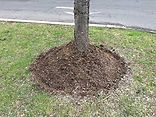January

Another New Year and during the past few weeks there was a long period of frost when the ground was so hard I couldn't dig up potatoes and carrots, so had to buy some from the farm shop! Garlic and sweet pea seeds would have loved it though. That was followed by warm, wet weather - ideal conditions for growth in most plants. Keep an eye out for weeds as plants such as chickweed seem not to ever sleep! The more diligent you are now, the easier work in the beds will be come springtime.
Seed Sowing

Buy in fresh seed compost for early sowings of annuals. Old compost is better used as a soil conditioner around the garden as the fertilisers in them break down into different chemicals that won’t help new seeds. There are a number of ways that seeds can be sown and we all have our favourite method, but I prefer using modules and try to sow one seed per individual module – one job I do not like is pricking out and potting on! Before sowing fill the containers lightly with the compost, water well and leave to drain. Once the seeds have been sown, keep moist but not wet. Check whether they need darkness or light to germinate. If the former, cover the tray with newspaper until seedlings appear. If light is required, vermiculite can be used to cover the seeds rather than more compost.


If you missed sowing sweetpea seeds in the autumn, they can still be done between now and the end of January. Sweetpeas like cold conditions to develop a good strong root system before planting out, so pop the seeds into seed compost in deep pots and cover with a good layer of compost. I do have some long modules for sweetpeas, but empty loo rolls filled with compost and stacked side by side in a seed tray work well. Don’t forget to pinch out the growing tips after 3 or 4 leaves are showing to encourage bushier growth and therefore more flowers.

Border Plants
Tidy perennials that don't require cutting right back to the base by removing sagging old stems. Overwintering plants need to be checked for aphids and other pests and action taken where necessary that could mean using a pesticide.
Check hellebores for dark patches on the leaves and, if found, cut from the plant and dispose, but not in your compost as this could be leaf spot that spreads.
Clear any weeds and spread mulch around the base of plants - leaf mould is particularly good as it is full of health nutrients for the soon to be waking plants.
Shrubs & Trees

Provided that the ground isn't too hard to dig, bare rooted trees, roses, hedges, shrubs can be planted during January. Dig a hole wider than the diameter of the root system and deep enough to accommodate planting to the nursery line of the plant. Don't be tempted to dig a shallow hole and pile the soil around (as in the picture on the right) as this will only result in poor growth, bark rot and disease. Ensure all weeds seen are removed including their roots, then scatter fresh compost and grit around the base of the hole before placing the plant. Fill the hole with more compost and soil, but don't tread it in as compacted soil restricts the journey of root shoots. Gently wriggle the plant as you fill in so the soil falls around the root system and water in. As water will take the soil down over a couple of days, top up the compost/soil as needed, then spread some mulch.

Fruits & Berries

Think about growing blackberries on a thornless shrub! It can be done with a couple of varieties – ‘Loch Ness’ and ‘Waldo’. Having ripped my fingers on wild bushes in the garden and on the hedgerows, I am definitely going to try these next year. Best planted against a wall or fence, they will also thrive on post and wire supports in open ground. For existing blackberry bushes, as blackberries fruit on canes produced the previous year, this year’s fruited canes need to be cut out and replaced with new ones produced this season.
Vegetables

January is the right time to get potatoes chitting (or sprouting) and all you need are a few empty egg boxes and somewhere light and airy, but away from direct sunlight. Rub out all but 2 or 3 ‘eyes’ and place them individually in the boxes with the remaining shoots at the top. By minimising the number of shoots, there’ll be less competition for nutrients once planted in the ground ensuring healthy, abundant tubers. Put the boxes in your chosen place and forget about them for at least 6 weeks. Will talk about planting these later.


There are a number of early vegetables, such as lettuce, summer brassicas, spinach, turnips,
that can be sown in January, but you’ll need to keep them indoors for now and prepare the ground they’ll ultimately be planted into. Place cloches over your planting area or a sheet of thick, clear polythene weighted down to keep the ground dry and warm. Seedlings can then be planted in mid-February onwards under the cloches or protected with fleece once the polythene sheet has been removed.
In mild areas, broad beans can be sown outside, but, again, cloches will help to keep the site warm.

Normally, I would also suggest that empty beds are dug over in January, but I am now firmly enmeshed in the no-dig scenario - more about that later!
